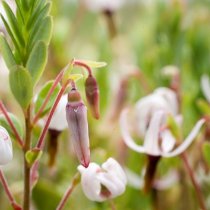
Uncooked Cranberry Relish
Ingredients:
1 12-ounce bag of whole fresh cranberries, washed and patted dry (remove any bruised or unripe fruits)
1 thin-skinned, seedless orange
1 C sugar
Directions:
- Wash the cranberries and orange and pat dry. Remove any bruised or unripe berries.
- Cut the oranges into quarters. Remove the seeds and then chop them up roughly.
- Either in an old-fashioned meat grinder or food processor, chop the raw cranberries and oranges.
- Transfer to a glass or ceramic serving bowl and add the sugar.
- Cover with plastic and let stand for 24 hours. Refrigerate after that; this will keep for 2 weeks.
- Leftovers can be used as a dressing for leftover turkey sandwiches.
Story:
The recipe above is an old-fashioned salad for holiday tables. What canned, cooked, or other cranberry recipes are in your food heritage? Cranberries or Mashkiigimin in Ojibwe have been used by American Indians for many purposes. The berry has immense medicinal properties. It is high in antioxidants and many other nutrients. Its juice can be used as a dye to brighten the colors of blankets and rugs. English settlers thought the cranberry flower resembled a Sandhill Crane and gave it the name “cran” berry as you can see in the photo above from the Wisconsin Cranberry Growers. The site also has some great recipes!
Today, cranberries are farmed. They don’t grow in water, but on land. Wisconsin cranberry marshes are flooded when the fruit is fully ripe to help in the harvest. Inside each berry are small air pockets that allow them to float so modern harvesting machines can easily pick them up. Cranberries are the leading fruit crop of Wisconsin, its official state fruit. Sauce, dried and fresh cranberries make up 95% of its use. Because of their tartness, only about 5% are consumed as juice. Cranberry information is from the American Indian School Nutrition toolkit.
If you would like to be notified when we share new recipes, be sure to scroll to the bottom, provide your email address, check the box confirming you are not a robot, click on a few photos to prove it and click subscribe! You will then receive an email after each new post. Remember, we're always looking for new recipes, so keep sending them to ecopact@fspa.org!





Post a Comment